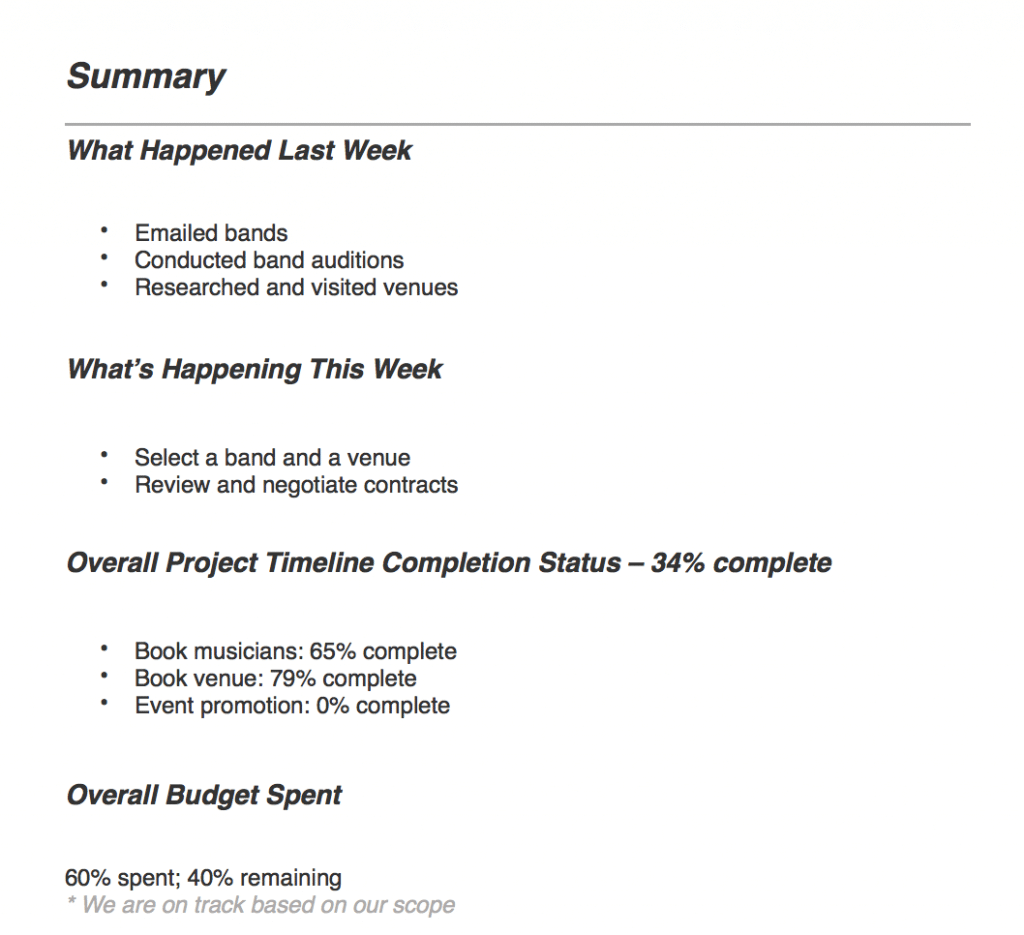A lot of tracking, evaluating metrics and analyzing trends happen between the to-do and lines to ensure a project is done successfully, on time, and within budget.
So, how can you make sense of all that data as a project manager?
This is accomplished through project management reporting. So, let’s see the tools and software available now for project management reporting and some examples of the project report.
What is Project Reporting?
In project management, reporting simply refers to delivering a high-level summary of the key data generated by the project in a straightforward, easy-to-use style. Project reporting is critical to project management success because it gives a window into what is going on and what needs to be done for the entire team.
Learn how to use simpler, smarter project reporting to drive better projects.
Why is Project Reporting so Important in Project Management?
Without sufficient project management reports, the project team and project stakeholders are left in the dark, unable to pinpoint what is going on with the project. As a result, it is all too simple for the project to fail since the relevant insights aren’t coming through and, as a result, appropriate judgments aren’t being made.
Project reporting meets the requirement for information in the management process by transporting data from where it is generated to where it is analyzed and applied.
Overall, project management reports are essential since they:
- Displays what is working for the project management team so that they can explain why it is working and focus more on it.
- Discovers what isn’t working so that the team may explore and choose the best course of action, i.e. what to do about it.
- Provide the team with a 360-degree perspective of how the project is progressing so that they may decide what steps to take next.
Let’s look at some of the most frequent sorts of project reports and how to make them work for you.
Types of Project Management Report
Project reporting is more than merely informing your team and stakeholders about the most recent project updates. Project reports can also be used to reduce risk, monitor budgets and timetables, and create more accurate project plans.
Here are a few project reports you might be interested in:
- Team Availability Report
- Report on the Status
- Project’s Health Report
- Risk evaluation
- Report on time tracking
- Reports on baseline conditions
#1. Team Availability Report Example
So, if you want to create an accurate project plan, you must first determine what resources are available to complete the task. A team availability report informs you how much work each team member has on their plate, allowing you to make informed project resource decisions.
#2. Status Report Example
A weekly status report is a simple method to keep your team and stakeholders up to date and manage expectations as a project moves forward. In your project management status reporting, we recommend evaluating the following fast hits:
- Work that is finished
- Work that will be completed in the near future
- Overall project completion and expenditures
- Items for Action
- Project dangers or concerns
So, here’s an example of a free status report template for project management:

#3. Project Health Report Example
A project health report gives a high-level overview of the project’s current state. It’s ideal for displaying on-screen in meetings with your team and stakeholders so that everyone can see at a glance what’s on track, what’s falling behind, and what’s already past due.
#4. Risk Assessment Example
A risk assessment allows you to identify and classify project risks based on their severity and chance of occurrence. That way, you can prioritize concerns and avert risks before they derail your project’s success.
#5. Time Tracking Report Example
A time tracking report shows you how much time your team is actually spending on project tasks, allowing you to assess how it compares to your project estimate. So, this allows you to anticipate potential budget overruns and provides vital data for future project estimations.

#6. Baseline Report Example
A baseline report compares your original timeline to your actual project timeline so you can learn from the past as you plan future projects. It’s also useful for demonstrating how modifications or delays impact the entire project timeframe.
So, this is an example of a baseline report, with the planned timeline in gray and the actual timeline in blue.
How to Write a Good Project Management Report
So, the goal of project management reporting is to provide all of the information generated by your projects in a simple format that stakeholders can understand and apply. Here are some best practices for creating management reports that will allow project stakeholders to make informed decisions.
#1. Keep data at the forefront.
The purpose of project management reports is to provide processed data to those who require it so that they can be informed and make appropriate decisions. Hence, it is critical that reports present solid data that stakeholders can use to get a sense of the big picture.
#2. Make a data visualization.
Use a plethora of images, charts, and graphs whenever possible to thoroughly demonstrate the significance of whatever data you offer using visual project management reporting tools.
#3. Allow for constructive communication by leaving the stage open.
Reports should not be full-stops that spit out data and move on; instead, reports should attempt to explain the data and its implications while inviting additional questions. It may be difficult, but doing so ensures that all stakeholders are on the same page and have a complete understanding of what you’re trying to convey.
#4. Create reports that are relevant for your target audience.
Senior management will not have the time to comb through minor details, and team members will struggle to make sense of a report that has only a few data, charts, and notes. Reports must be tailored to the demands of your target audience so that they receive all of the information they require without becoming bogged down or left in the dark due to inadequate data.
Tools and Software for Project Management Reporting
Are you looking for the best project management reporting software or tools for your organization? You’ve come to the right place! We’ve simplified the work by compiling a list of 10 project management reporting software and tools.
Examine the tools’ key features, cost, and what makes them unique – and choose a solution that works for your company.
#1. Scoro
Scoro is a comprehensive solution that integrates all of the project management software elements you can need: projects and tasks, contact management, quotations, team collaboration, billing, and reporting.
The following are the features:
- Projects with sub-tasks and time constraints
- Dashboard for Key Performance Indicators (KPIs) in Real Time
- Team calendar and meeting scheduling
- Contact management
- Work time tracking and billing
- Detailed financial and project progress reports
- Pre-set templates for quoting and invoicing
Pricing starts at $26 per user per month.
#2. ProofHub
ProofHub replaces traditional emailing and many other tools by combining multiple project management features like reporting under one roof.
The following are the features:
- User roles have been assigned.
- Online team meetings and chats
- Delegating tasks and assigning responsibilities
- Reporting on and tracking the progress of a project
- File storage that is secure
Pricing starts at $45 per month.
#3. Basecamp
Basecamp is the go-to tool for thousands of project management teams, who appreciate its modern social media-like interface and easy team collaboration features.
The following are the features:
- Projects to manage the work of multiple users
- Discussion boards for new projects or ideas
- Collaboration with the team within the app
- Project performance reporting
- Clients will see a separate dashboard.
- Email and desktop notifications
Price: Free plans are available, with paid plans beginning at $99 per month.
#4. Asana
Asana combines elements of project management, file storage, and collaboration and helps to manage projects across a team without email.
The following are the features:
- Tasks and team assignment
- Timelines and roadmaps for projects
- Team growth and milestones
- Bug reports and sprints should be filed and tracked.
- Project dashboards for a quick overview
Pricing: Free for up to 15 members, premium options start at $13 per user per month.
#5. Citrix Podio
Podio is a highly adaptable and adjustable web center for work and team communication.
The following are the highlights:
- Tasks can be assigned, files can be attached, and specifics can be discussed inside the solution.
- Distribute encrypted and big files.
- Automate sales funnels and project budget tracking.
- A visual dashboard provides an overview of the firm.
Pricing starts at 19.20$ per user per month for a full range of features.
#6. Workzone
Workzone was created by seasoned advertising executives who intended to help agencies and creative teams gain visibility over their whole portfolio.
The following are the features:
- To-do lists that are unique to each person
- Make a list of subtasks and task dependencies.
- Configure access to projects, tasks, and files for particular users (including customers).
- Gantt charts allow you to quickly see statuses.
- Assign people to multiple tasks.
Pricing starts at $24 per user each month.
#7. JIRA
JIRA is a cross-platform issue and bug tracking software with comprehensive project management features like reporting.
The following are the features:
- Plan sprints by creating user stories and issues.
- Distribute duties across your software team members.
- Prioritize and discuss the work of your team.
- Organize your team communication.
- View real-time reporting on the work of your team.
Pricing starts at $10 per month for up to ten users, $75 per month for fifteen users, and $300 per month for fifty users.
#8. Notion
Notion will provide you with an entirely new perspective on project management. It aids in project planning and discussion, sharing information with the team, and keeping track of all ideas.
The following are the features:
- Maintain a weekly checklist for yourself and take notes.
- Create a task board using a drag-and-drop editor.
- Stack pages on top of each other to create an infinite knowledge base.
Pricing: $8 per user per month
#9. Trello
Trello is well-known for visualizing project activities on a cardboard-like dashboard, which is ideal for managing short and rapid daily tasks.
The following are the features:
- Simple job management on a piece of cardboard
- Creating an infinite number of task lists
- Sharing of images and files
- Lists can be organized by date or priority.
- Collaboration and commenting
Pricing: Personal use is free, while corporations must pay $9.99 per user each month.
#10. ActiveCollab
ActiveCollab is a project management software that helps your team stay organized while email becomes obsolete.
The following are the features:
- Invoicing and time tracking
- Planning timeline in the form of a Gantt chart
- Cards for Kanban
- A shared team calendar to facilitate collaboration
Pricing starts at $6.25 per month for members.
What Various Forms of Project Reporting Are There?
Daily, weekly, monthly, and quarterly project status reports are some of the available formats. They streamline the procedure for acquiring and communicating important project-related information.
Is Excel a Tool for Reporting?
Excel is a fantastic tool for managing and analyzing data, but it is ineffective for reporting. You can leverage the data from Excel and any other tools your team uses to create successful reports by connecting Excel to a reporting software like Databox.
What Serves as Reporting’s Primary Objective?
Research findings are presented and discussed in reports. The justification for the research, a description of the research methodology, the findings, results, a logical discussion, and conclusions/recommendations are all given to the reader.
What Does a Project Reporting Structure Entail?
To establish the hierarchy and power of those involved in a given project, an organizational structure for project management is used. On a chart that team members can refer to while working on a project, the structure specifies the roles and reporting lines for each team member.
What Is the Format of a Report?
Report writing is a formal way of writing in-depth about a subject. A report’s writing style and tone are always formal. The target audience is the segment on which you should concentrate.
Is Python Used for Reporting?
In addition to data analysis, Python is useful for automating repetitive processes like reporting.
Project Management Reporting FAQ’s
What is reporting in project management?
In project management, reporting simply refers to delivering a high-level summary of the key data generated by the project in a straightforward, easy-to-use style.
Why do we use reporting software?
Reporting software connects to data sources, gathers information, and provides insights in the form of graphs and charts based on the input data, allowing the user to uncover important information. The decision-making process is aided by the reporting tools. Detailed insights will give you greater control over data.
What does a project report include?
Project management report consists of information on economic, technical, financial, managerial and production aspects.










